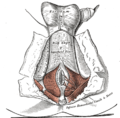| Inferior rectal artery | |
|---|---|
 The inferior rectal arteries(unlabeled) surround the anus. | |
 | |
| Details | |
| Source | Internal pudendal artery |
| Vein | Inferior rectal veins |
| Supplies | Anal canal |
| Identifiers | |
| Latin | arteria rectalis inferior, arteria haemorrhoidalis inferior |
| TA98 | A12.2.15.039 |
| TA2 | 4342 |
| FMA | 20824 |
| Anatomical terminology | |
The inferior rectal artery (inferior hemorrhoidal artery) is an artery that supplies blood to the lower third of the anal canal below the pectinate line.
